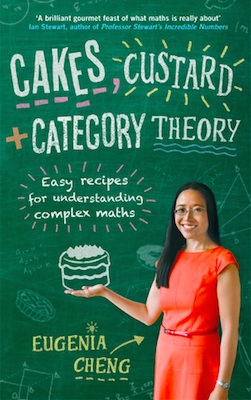
We’ve often mentioned category theorist and occasional media-equation-provider Eugenia Cheng on the site, and she’s now produced a book, Cakes, Custard and Category Theory, which we thought we’d review. In a stupid way.

We’ve often mentioned category theorist and occasional media-equation-provider Eugenia Cheng on the site, and she’s now produced a book, Cakes, Custard and Category Theory, which we thought we’d review. In a stupid way.
Phil Ramsden gave an excellent talk at the 2013 MathsJam conference, about a particularly mathematical form of poetry. We asked him to write an article explaining it in more detail.
Generals gathered in their masses,
Just like witches at black masses.(Butler et al., “War Pigs”, Paranoid, 1970)
Brummie hard-rockers Black Sabbath have sometimes been derided for the way writer Geezer Butler rhymes “masses” with “masses”. But this is a little unfair. After all, Edward Lear used to do the same thing in his original limericks. For example:
There was an Old Man with a beard,
Who said, “It is just as I feared!-
Two Owls and a Hen,
Four Larks and a Wren,
Have all built their nests in my beard!”(“There was an Old Man with a beard”, from Lear, E., A Book Of Nonsense, 1846.)
And actually, the practice goes back a lot longer than that. The sestina is a poetic form that dates from the 12th century, and was later perfected by Dante. It works entirely on “whole-word” rhymes.
Note: If you’re looking for instructions on solving Rubik’s cube from any position, there’s a good page at Think Maths.
One day some years ago I was sat at my desk idly toying with the office Rubik’s cube. Not attempting to solve it, I was just doing the same moves again and again. Particularly I was rotating one face a quarter-turn then rotating the whole cube by an orthogonal quarter-turn like this:
Having started with a solved cube, I knew eventually if I kept doing the same thing the cube would solve itself. But this didn’t seem to be happening – and I’d been doing this for some time by now. This seemed worthy of proper investigation.
The “Futurama theorem”, also known as Keeler’s Theorem after its creator, was a bit of maths invented for the Futurama episode The Prisoner of Benda, to solve a problem where the characters get their heads mixed up and need to swap them back without any one pair swapping heads twice. It was enthusiastically reported by the geeky press, and rightly so, because it’s a fun bit of real maths with a wonderful application. Dana Ernst has written some very good slides about the theorem, working from “what is a permutation?” up to the algorithm itself.
Anyway, some students from the University of California, San Diego have extended the result, giving a better algorithm for finding the minimum number of switches to put everyone’s head back in the right places, give optimal solutions for two particular situations, and give necessary and sufficient conditions for it being possible to represent the identity permutation as $m$ distinct transpositions in $S_n$.
Paper: http://arxiv.org/abs/1204.6086
via James Grime